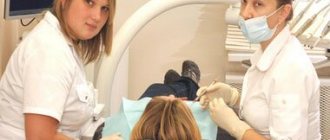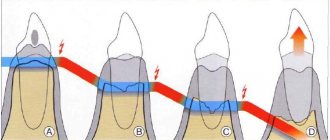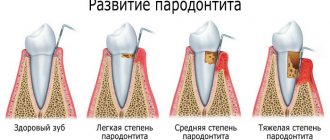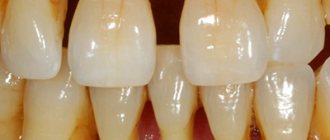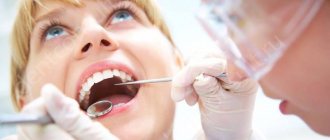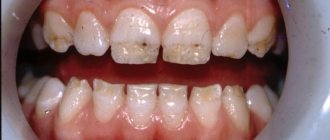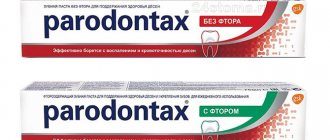Have questions?
Periodontitis is an inflammation of the tissues that surround the tooth and hold it in place.
Periodontium refers to all the tissues located around the tooth: the bone formations in which the tooth root is located, its ligamentous apparatus and, of course, the soft tissue of the gum itself.
Today, approximately half of all dental patients are diagnosed with periodontal diseases. They are the most common cause of tooth loss in older people.
WHAT IS PERIODONTAL
The periodontium is the complex of tissues surrounding the tooth. These include not only the gums, but also the bone socket in which the tooth root is located, and the tooth ligaments that hold the tooth in the socket, intertwined with the tooth root and bone. All these tissues represent a single system that performs several important functions at once: fixation of teeth, perception and regulation of chewing load, control of the work of masticatory muscles, protection against penetration of pathogenic bacteria and a number of damaging factors into the bone tissue.
What is periodontitis
Periodontitis is one of the most common dental diseases. Symptoms of periodontitis can affect many people to varying degrees for a variety of reasons.
But, despite this, many people often do not pay special attention to the first signs of this disease, as a result of which periodontitis can worsen and develop into severe forms of the disease, which, in turn, most often leads to the loss of a tooth or even several teeth, and as well as other complications.
Periodontal tissue surrounds the root of the tooth and is designed to hold the teeth firmly in place. In other words, periodontal tissues include vessels, hard fibers and channels involved in the process of feeding hard tissues.
Periodontal pathology is an inflammation of its tissues, the cause of this inflammation is the penetration of infection into the periodontal tissue. Periodontitis often occurs as a result of a complication of gum disease such as gingivitis, or due to untreated caries.
Periodontitis in severe advanced form and in the acute phase is accompanied not only by bleeding gums, but also by purulent discharge and ulceration of the gums (formation of ulcers on the gums).
If periodontitis starts and treatment is not started on time, the inflamed gum tissue begins to peel off from the roots of the tooth, causing the teeth to become loose, and if treatment is not started, the teeth may begin to fall out.
Also, periodontitis can develop during pregnancy, since during pregnancy there is a temporary decrease in natural immunity, while the progression of the disease in the first stages is often characterized by a latent course.
In this case, as a treatment, dentists try, if possible, to limit themselves to the use of gentle medicinal treatment methods, and continue treatment after the woman is ready for more serious therapy.
HOW DOES GINGIVIT MANIFEST, AND WHY DOES IT OCCUR?
With superficial inflammation of the gums (if only soft gum tissue is involved in the process), we are dealing with gingivitis. Inflammation can occur in the area of 1 - 2 teeth (local gingivitis) or all teeth (generalized gingivitis).
Inflammation of the gums usually begins with damage to the gums, for example, when eating, brushing teeth, an incorrectly applied filling or crown, or a chemical burn. In this case, pathogenic microorganisms penetrate the injured gum and intensify the inflammatory response. The presence of soft plaque, tartar, and poor oral hygiene are mandatory conditions, and very often an independent cause of the onset and maintenance of the disease.
Gingivitis is often observed in people with malocclusions, crowded teeth and their incorrect position. A short frenulum of the upper and lower lips is also a risk factor for periodontal disease.
Smoking plays an important role (spasm of blood vessels occurs, gum nutrition deteriorates), decreased body defenses (immunodeficiency), lack of vitamin C and other risk factors.
In the acute stage of the process, pain, burning, swelling of the gingival margin, and bleeding when brushing teeth are usually noted. If the cause of the disease is not eliminated, then acute gingivitis becomes chronic, which does not go away on its own without treatment. In this case, the gums turn blue and periodically bleed when brushing your teeth and eating. There is an unpleasant odor from the mouth.
Severe forms of gingivitis, such as ulcerative gingivitis, are observed in severe general diseases of the body. For example, with diabetes or a serious immunodeficiency disease. In this case, the temperature rises, painful ulcers covered with a film appear on the dirty gray gums, and general health worsens.
With gingivitis, the teeth remain stable, since the process does not penetrate deep into the periodontium, the so-called periodontal pocket does not form, and the bone tissue of the tooth socket does not dissolve. Can there be consequences if gingivitis is not treated?
If gums are not treated in time, gingivitis will develop into periodontitis. This is a much more serious and dangerous disease than gingivitis. Often it becomes irreversible, since periodontitis affects and destroys the deep tissues of the periodontium - the ligaments of the tooth and the bone tissue of the jaw.
Symptoms of periodontitis
The manifestations of periodontitis depend on how advanced the disease is. The main symptoms of periodontitis include the following:
- bleeding gums;
- plaque in the root area of the teeth and under the surface of the gums;
- the occurrence of bad breath;
- swelling of the mucous membrane;
- redness of the mucous membrane due to the onset of the inflammatory process;
- blue mucous membrane due to inadequate blood supply to the gum area;
- the presence of pockets with purulent contents;
- pain during chewing and brushing teeth;
- exposure of tooth roots;
- change in the color and viscosity of saliva.
WHAT FACTORS PROMOTE THE DEVELOPMENT OF PERIODONTITIS?
The causes of periodontitis are the same as those of gingivitis. Often periodontitis is associated with chronic gingivitis. If the traumatic factor persists, microorganisms actively continue to multiply in the damaged gum. Their toxins and enzymes destroy the gums deeper and deeper.
As a result, the connection between the gum and the tooth (the bottom of the periodontal sulcus) is disrupted - a very important protective formation that protects the tooth ligaments and bone from infection. A periodontal pocket appears, and now bacteria, plaque, etc. rush into the depths of the periodontium - this is where periodontitis begins. Next, gradual destruction of the tooth ligaments occurs, and the bone tissue melts.
Periodontitis can be acute or chronic. Typically, acute periodontitis occurs when there is deep, strong trauma to the gums (for example, a long artificial crown, a toothpick). In this case, the periodontal connection may be immediately disrupted - gingivitis and periodontitis occur simultaneously.
Generalized periodontitis is characteristic of serious general diseases of the body - diabetes, other endocrine diseases, radiation sickness, severe diseases of the gastrointestinal tract and cardiovascular system. It is almost impossible to cure such periodontitis without general treatment of the underlying disease.
In the chronic process, pain and swelling are not as pronounced as in acute periodontitis, the amount of tartar and soft plaque increases, the bad breath increases, the gums begin to settle, exposing the neck of the tooth, teeth become sensitive to cold, hot, sour and salty. Tooth mobility appears, unnoticeable at first, but steadily increasing.
Suppuration of periodontal pockets is often observed. Pus is released from under the gum when pressing on the gum edge with a finger. Sometimes, in the absence of outflow of pus, periodontal microabscesses occur - in this case, the patient already requires surgery.
Periodontitis can be one of the causes of some common diseases. The microorganism that causes stomach ulcers is often found in dental plaque. Other bacteria living in dental plaque can lead to the formation of microthrombi (blood clots). Penetrating into the blood (with bleeding gums), they increase the risk of cardiovascular diseases, including myocardial infarction. The entry of microorganisms into the blood can lead to septic endocarditis. There is information about the relationship between chronic dental and periodontal diseases and kidney damage. Remember that the focus of chronic infection in the oral cavity is the entry point for pathogenic bacteria into the body.
Classification and forms of periodontitis
Before starting treatment for periodontitis, the dentist conducts a diagnosis, the purpose of which is to determine the form and stage of the pathology. Based on the study of the characteristics of the course of the disease, the following types of periodontitis are distinguished:
Acute stage of periodontitis: this stage is characterized by the rapid development of foci of infection, which in a short period of time can lead to serious complications. The gums begin to bleed heavily, and acute painful sensations appear when pressing on areas of inflammation, brushing teeth, or eating hard foods.
Within a very short time (several days), periodontitis can lead to the rapid formation of significant abscesses and the subsequent formation of fistulas.
Chronic form of periodontitis: when periodontitis is chronic, the pathology usually does not manifest itself with such pronounced symptoms as in acute cases. The patient may not experience any discomfort or experience minor discomfort, but this fact does not mean that the inflammatory process does not occur and does not develop.
DIFFERENCES PERIODONTOSIS FROM PERIODONTITIS
Periodontal disease is a degenerative lesion of all periodontal tissues; this process never occurs in an acute form and is not associated with exposure to bacteria. There is a slow, uniform resorption of the bone tissue of the teeth cells and subsidence of the gums with exposure of the roots of the teeth. Periodontal disease is always a generalized process, that is, all teeth on both jaws are affected. Bone tissue atrophy is usually painless, continuous and, if left untreated, leads to the complete disappearance of the ligamentous apparatus, the walls of the tooth sockets and their loss. Inflammatory phenomena are associated with periodontal disease quite rarely.
The exact cause of the disease is still unknown. It is believed that the onset of the disease is associated with impaired blood circulation in periodontal tissues and endocrine disorders. The development of periodontal disease is promoted by diabetes, cirrhosis of the liver, gastric ulcer, neurogenic diseases, cardiovascular pathology (atherosclerosis), hypovitaminosis and a decrease in the body's overall resistance.
Local factors, for example, the impact of microorganisms on the periodontium, can only aggravate the course of the disease, therefore, in periodontal disease, the primary process is the resorption of bone tissue and the ligamentous apparatus of the tooth, and superficial changes in the gums are secondary.
Periodontal disease progresses slowly. Clinically, it manifests itself with significant changes in the periodontium. This is subsidence of the gums, exposure and increased sensitivity of the necks of the teeth, itching in the gums. Teeth remain stable for quite a long time.
A characteristic sign of periodontal disease is the presence of so-called wedge-shaped tooth defects - damage to the enamel of the teeth near the gums in the form of fairly deep oval cavities. Currently, this phenomenon is explained by a malnutrition of the tooth, inferior enamel and dentin, combined with very strong pressure on the toothbrush during frequent brushing. Periodontal disease is characterized by the absence of periodontal pockets.
Generalized periodontitis: symptoms and treatment
Periodontitis is a very common pathology of periodontal tissues (soft tissue structures around the dental unit).
If the pathological process is started and left without treatment, then you can lose all the dental units. Periodontal pockets are the best location for the emergence and development of an infectious process, which does not have the best effect on the healthy state of the body. A beautiful and healthy smile gives you self-confidence and makes you feel natural. When periodontal tissue is damaged, the gums become red and swollen. The disease affects the overall health of the body and the well-being of a person. If something bothers you in the oral cavity, you should immediately consult a specialist. Dentist therapists at the branches of the West Dental family clinic in Yanino-1 and Vsevolozhsk will help with identifying the origins of anxiety and their treatment.
It has been scientifically determined that the occurrence of periodontitis is influenced by: soft plaque and hard deposits; filling material or orthopedic structure fixed in violation of treatment protocols.
WHY IS PLAQUE A MAIN CAUSE OF PERIODONTAL DISEASE?
Bacterial plaque is a sticky, colorless film that constantly forms on teeth. If plaque is not removed, it will harden and form a rough, porous growth called tartar. Bacteria in tartar produce toxins (poisons) that irritate the gums, causing them to become red, tender, swollen, and bleeding. As the disease progresses, toxins can lead to periodontal destruction and the formation of pockets that fill with plaque. The bone that supports the teeth is subject to constant destruction. Consistently removing plaque through brushing, flossing, and professional care can minimize the risk of gum disease. However, if no treatment is given, the affected teeth may become loose and eventually fall out.
Diagnostics
To determine the disease and its severity, various diagnostic methods are used. For generalized periodontitis, differential diagnosis includes an extensive consultation examination to draw up a medical history (formation plan):
- collection of complaints (mobility of units, discomfort when chewing, periodic sharp pain in the attached gum);
- visual and instrumental examination (gingival pockets, recession of gingival tissue, dental plaque, reddish gums);
- determination of the color, shape and structure of gum tissue;
- finding out what condition the dental units are in: percussion, palpation, degree of mobility;
- determination of hygiene indices;
- RG images.
Sometimes, a specialist may prescribe a blood test to clarify the etiology.
Diagnostic measures should take into account not only all the symptoms of the pathology and the patient’s complaints, but also the mandatory performance of an X-ray. Basically, in case of periodontitis, it is recommended to perform an OPTG (orthopantomogram) - a panoramic image. In such an extensive image, all dental structures and the degree of bone damage in each unit are immediately visible.
WHAT IS A PERIODONTAL EXAMINATION?
The history of the disease (anamnesis) is carefully determined. When did it first start, what was done for treatment, do parents and close relatives have this disease, etc. Careful collection of data makes it possible to determine risk factors and sometimes even predict the course of the disease. This is followed by a careful examination of the oral cavity: the frenulum of the lips and tongue, the dental arches as a whole and, if necessary, each tooth separately, as well as fillings, crowns and orthodontic appliances are assessed.
One of the main examination methods is probing the periodontal pocket of each tooth at six points. The presence of tartar and soft plaque, bleeding, suppuration, tooth mobility, etc. is assessed. This labor-intensive analysis is painlessly performed in 15 - 20 minutes using a special electronic probe of the automated computer clinical diagnostic system Florida Probe (USA). The patient’s personal data is stored in the computer’s memory, which makes it possible to predict the course of the process and select treatment, as well as evaluate the dynamics of the disease and the effectiveness of the treatment.
An orthopantomogram is a necessary element in the diagnosis of periodontal diseases. This image shows the teeth, jaw bones, and the partitions between the teeth. Digital orthopantomographs (such as the ones in our clinic) allow you to obtain excellent images with minimal radiation exposure to the patient and evaluate them on a computer screen using auxiliary computer programs.
Why does this pathology occur?
The most common causes of periodontitis are:
- the presence of tartar in which microorganisms actively multiply;
- malocclusion;
- irregularly shaped dental crowns and roots;
- systematic neglect of oral hygiene;
- eating disorders;
- overload of one side of the jaws with asymmetrical distribution of chewing loads;
- consequences of poor quality prosthetics;
- serious systemic pathologies (diabetes mellitus, immunodeficiency states, diseases of the circulatory system, etc.), which also affect the condition of the oral cavity.
WHAT IS MEAN BY PERIODONTAL TREATMENT
After collecting all the necessary information, the periodontist will discuss the condition of your gums with you and suggest the most optimal treatment. Most importantly, it must be comprehensive - that is, treatment must cover all identified causes and associated factors that support the disease. Only in this case can it be possible to completely cure or stabilize periodontal disease for a long time.
Treatment will be much more effective if the patient strictly follows all instructions and strictly follows the chosen treatment plan.
Typically, a comprehensive treatment plan consists of general and local treatment and includes all or part of the methods listed below.
Treatment of chronic periodontitis
Therapy for chronic periodontitis has several goals: to reduce the patient’s discomfort, stop inflammation and eliminate its causes, and restore damaged periodontal tissue. As a rule, doctors prescribe comprehensive treatment for periodontitis, which includes:
- professional cleaning (removal of plaque and tartar);
- antibacterial and anti-inflammatory therapy, as well as stimulation of tissue regeneration;
- physiotherapeutic procedures - electrophoresis, laser therapy, darsonvalization, etc.;
- surgical intervention - curettage (treatment of gum pockets);
- splinting to secure mobile teeth;
- opening of abscesses, removal of teeth with pathological mobility, osteoplasty;
- treatment of diseases that contribute to the development of periodontal disease (diabetes, gastritis, etc.);
- correction of occlusion.
You should be prepared for the fact that treatment of periodontal tissue will take time, especially if the patient consulted a doctor with moderate or severe chronic periodontitis. Restoring the affected areas can take from several months to several years, although in complex cases, losses cannot always be completely restored. But with due attention, regular visits to the periodontist and maintenance therapy, stable remission can be achieved.
ELIMINATING TRAUMATORY FACTORS DURING TREATMENT
Treatment begins with the elimination of traumatic factors - low-quality fillings and crowns with an overhanging or very deeply embedded edge in the gum, bridges, traumatic teeth, etc. are removed.
The so-called selective grinding of teeth is carried out in order to eliminate excessive traumatic load when chewing from overloaded teeth. At the same time, small areas of the teeth are slightly undermined, which do not allow the upper and lower rows of teeth to meet correctly, thereby causing them to be overloaded.
This is an absolutely harmless procedure, since the ground areas of the teeth are polished and coated with fluoride preparations. In this case, caries does not occur.
Professional oral hygiene The next stage of treatment (performed in 100% of cases) is professional teeth cleaning: it allows you to remove even tartar located deep under the gum (this is the strongest traumatic factor). In addition to tartar and soft plaque, dense dark plaque (from smoking, drinking tea, coffee, and other dyes) is simultaneously removed - this allows you to restore the beautiful appearance of your teeth. After removing tartar and plaque, the doctor will definitely polish the cleaned surface of the root and crown of the tooth.
Nowadays, several methods of removing dental plaque are common. Cleaning teeth with a stream of air mixed with cleansing powder and water (the most famous representative is the Air Flow system) perfectly cleanses teeth of soft plaque, dark plaque from tobacco or coffee, even in hard-to-reach places. Ultrasonic scalers are capable of removing tartar of almost any size.
Removing tartar is one of the most important and effective stages in the treatment of periodontal diseases.
Anti-inflammatory therapy Drug therapy of gums allows you to relieve inflammation - cope with pain, swelling, and reduce bleeding gums. Typically, periodontal pockets are washed with antiseptic solutions (chlorhexidine, iodinol, etc.), and various medicinal substances are used (enzymes, antimicrobial, hormonal, anti-inflammatory drugs). Often the gums are covered with a special bandage after the medication is administered.
Self-absorbing Diplen-Dent films impregnated with various medications (antibacterial, improving blood circulation, etc.) are very convenient. Such films are glued by the patient independently to the affected areas of the gums (for example, before going to bed) and, gradually dissolving, release the medicine directly into the gums. In the morning, all you have to do is remove the remaining film from the oral cavity.
Physiotherapeutic treatment There are many methods of physiotherapeutic treatment of periodontal diseases. Laser therapy is most widely used in our clinic. Therapeutic laser radiation has a very wide range of therapeutic effects - relieves pain, improves blood circulation, metabolism, stimulates immune defense.
Gum massage can be performed by a doctor or independently. At home, use your index finger to massage the area of the interdental papilla of the gum with up and down movements (6 to 10 movements per papilla). The massage ends with hygienic rinses. Massage should not be used if the disease is exacerbating or if there are erosions or ulcers on the gums.
Surgical treatment Periodontal surgery is a radical and one of the most effective methods of treating moderate and severe periodontitis. With the help of small operations, it is possible to eliminate periodontal pockets, remove overgrown infected soft tissues, eliminate suppuration of the gums (microabscesses), replant bone tissue or bone substitutes, lift receding gums and close small root exposures.
Every year new developments in the field of surgical treatment, modern materials and treatment methods appear. One of the promising innovations is surgical treatment using cellular technologies, which allows stimulating the restoration of bone tissue. This technology is widely used in our clinic. Surgical treatment is always carried out after removal of dental plaque and therapeutic treatment, when all acute symptoms of gum inflammation subside. All interventions are performed under local anesthesia and rarely take much time. Usually all postoperative phenomena subside after 2 - 3 days, and the sutures are removed, or they dissolve within a week.
The effect of such operations often lasts for a long time. A lot will depend on maintaining oral hygiene, following preventative rules and overall health.
Rational prosthetics and splinting Prosthetics of missing teeth and their permanent splinting (i.e. joining teeth together using a prosthesis or special light-curing threads) are the final stage of the treatment of periodontal diseases. It allows you to fully restore the function of chewing, eliminate aesthetic defects (in the absence of teeth visible when smiling), and unite all the teeth together, as intended by nature.
In this case, the load is distributed evenly throughout the entire dentition, which allows the supporting teeth to function much longer. Even the absence of one tooth causes a number of changes in the bone tissue of the jaw. If, after successful therapeutic and surgical treatment of the gums, rational prosthetics and splinting are not carried out, then the disease may worsen again in the very near future.
Prosthetics are carried out using both removable and fixed dentures, depending on the condition and number of teeth.
After completion of treatment, we advise you to strictly follow all the doctor’s recommendations. Be sure to visit your doctor at least 1-2 times a year for a follow-up examination and professional oral hygiene.
Stages of development of periodontitis. Localization of infection in periodontitis
Localized form of periodontitis: The onset of this type of periodontitis is usually caused by minor trauma to the mucosa. The localized form, in the absence of dental care, can progress to the next stage of the disease.
Generalized form of periodontitis: inflammation in the generalized form of the disease, inflammation develops along the entire length of the alveolar ridge. Experts in the field of periodontology argue that this form can quickly develop and become more complicated due to weakened immunity, for example, with a cold, hypothermia, infection with another infection, or self-medication with antibiotics.
Forms of periodontitis
According to the severity of periodontitis, there are: mild form, moderate form, severe form. At the beginning of the pathological process, slight bleeding, slight pain, and the formation of small periodontal pockets are observed. In the moderate form of the disease, large gaps appear in the periodontal pockets, and the teeth become mobile and loose. With the development of severe periodontitis, deformation of the interdental septa, decay of collagen fibers and root tissues are observed. Periodontal pockets become large, they contain purulent contents, and teeth fall out.
HOW MUCH WILL THE TREATMENT COST?
The cost of periodontal treatment will depend on the type and amount of work planned. When considering an investment in your own health, consider that treating gum disease is cheaper and better for your health than restoring a tooth lost due to untreated periodontal disease.
New direction – aesthetic surgical periodontology
Recently, such a direction as aesthetic surgical periodontics has appeared and is actively used in surgical periodontology. She deals with the correction of changes in the position of the gingival margin relative to the neck of the tooth, and gum growths. Aesthetic surgical periodontics includes a large number of new surgical techniques, depending on the clinical situation and the desired aesthetic effect.
What are the treatment options for periodontitis?
First of all, it should be noted that self-treatment of periodontitis at home without consulting a dentist often leads to neglect of the disease, complications and dangerous consequences. The treatment of periodontitis should only be carried out by a dentist, preferably a specialized specialist - a periodontist.
ARE THERE METHODS FOR PREVENTION OF PERIODONTAL DISEASES?
- Prevention of periodontal disease consists of several simple points:
- Brush your teeth 2 times (morning and evening) after meals. Use a toothpaste recommended by your doctor to protect your gums. Use an electric toothbrush - it perfectly cleans your teeth and massages your gums.
- Do professional oral hygiene at least 2 times a year, and at the same time you can undergo an examination by a periodontist. Do not use any medications for the treatment or prevention of periodontal disease (gels, ointments, tablets, etc.) without consulting your dentist.
- Do not eat only soft and delicate foods - your teeth should receive normal, natural stress.
- Your diet should be well balanced, contain the required amount of proteins, fats, carbohydrates, and vitamins. If you are deficient in vitamins, take multivitamin complexes.
- Lead a healthy lifestyle.
How does periodontitis occur?
As a result of several scientific studies, statistics were collected that showed that people between the ages of 30 and 40 most often experience periodontitis.
At the same time, these data do not allow us to assert that the occurrence of periodontal pathologies is directly dependent on a person’s age.
How to reduce the risk of periodontitis
To minimize the possible occurrence of periodontitis, you need to undergo preventive examinations with a dentist every six months, lead a healthy lifestyle, eat right and carefully observe oral hygiene.
Mild degree
As usual, mild degrees are not given any importance. A subgingival pocket is formed near the dental unit, where microorganisms accumulate. There are signs of periodontal inflammation, and on the Rg image there is destruction of bone tissue by 1/3 of the root, gum pockets up to 3.5 mm. In the cervical area of the teeth, hard deposits are observed, the gums are loose, slightly inflamed and swollen. There is slight bleeding when cleaning, and discomfort when chewing solid food. Mobility and movement of teeth is not observed at this stage.
Prevention of periodontitis
To prevent periodontal problems, the following measures must be observed:
- visit a hygienist in a timely manner, remove soft plaque and prevent the formation of hard dental deposits;
- use toothbrushes, brushes and dental floss recommended by your dentist for dental care, as well as soft plaque indicators for self-monitoring;
- perform oral hygiene twice a day, observing the time limit;
- adhere to a balanced diet: have solid natural foods in your diet;
- if disorders of the endocrine system are detected, undergo regular maintenance treatment from an endocrinologist;
- stop smoking, as nicotine negatively affects metabolic processes in the body.
Remember that your health is a very important component of your quality of life, take care of it!
Treatment
Therapy for the disease is complex and depends on the patient’s condition and the extent of the process:
- Drug treatment:
- local anti-inflammatory agents (chlorhexidine, chlorophyllipt, metronidazole gels);
- antibiotics for oral administration and injection (clindomycin, lincomycin).
- Physiotherapeutic treatment (electrophoresis, darsonvalization).
- Sanitation of the oral cavity:
- ultrasonic cleaning;
- treatment of diseased teeth;
- prosthetics;
- removal of teeth that cannot be treated.
- open and closed curettage of periodontal pockets;
- flap surgery.
